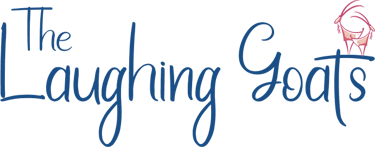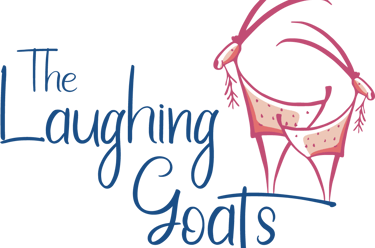

Health Vibes - Stretch for Mobility & No Pain
A morning stretch awakens your body, gives you mobility and dissolves pain. Dynamic & static stretching is also a must before & after workouts. Stretch for stronger muscles & bones, posture alignment, balance, and relaxation. You'll also have lower risk of injury. See why stretching is for everyone.
Did you know that inflammation in your body ages you faster? And, inflammation causes pain? Stretching is one of the best ways to keep your body pain free (assuming you have no serious illness/injury). Stretching allows you to keep a more youthful body. For example, look how infants & children move - they're flexible, agile, and mobile. As we age into our 30's and beyond, we need to stay active and stretch to keep our freedom to move.
Stretching for flexibility - to bend, twist, and move limbs in their full range of motion, and to be pain free (or almost).
Stretching for mobility - to move your body around freely & easily, to have better balance & posture alignment, to strengthen muscles and bones, to lower risk of injury, and to feel SOOO much better and more youthful.
Think about playing with your kids & grandkids, checking off your bucket list, and having the best quality of life possible. If you're not generally active - please stretch at least 5 days/week for mobility & no more pain. Stretching is not just for athletes or people like me who exercise and stay active. It's a game changing health benefit for everyone.


Stretch for Mobility & No Pain
Long Periods of Inactivity
Those who become inactive will eventually lose their independence, relying on walkers or wheelchairs to move around. Not for me, I like my freedom too much.
By stretching at least 5 days/week, you're conditioning your primary & secondary muscles and all the supporting connective tissues. Everything gets longer, leaner and more flexible. As the muscles become more conditioned, they can keep you younger.... past your 60's, 70's, and 80's. Simple tasks like grocery shopping get easier and more difficult activities like biking & kayaking become possible.
Inactivity can lead to life threatening disease: heart disease, obesity, and high blood pressure. Inactivity causes the loss of: muscle, strength, endurance, movement, and bone density. And weaker bones means more risk for fractures.
Inactivity also causes: a slower metabolism which can lead to weight gain, digestion problems, nutrient deficiencies, and a weakened immune system. Sleeping and sitting for long periods of time will cause slower blood flow & circulation which leads to stiffness and pain. Muscles need good blood flow to supply them with oxygen & nutrients.
Try doing easy activities like walking or gardening - which will increase blood flow. Then stretch.
Disclaimer: I am not a medical professional or sports therapist - the advice I offer is from 25 years of personal experience with exercise & stretching. Research has confirmed what I've learned and given me additional info to dive deeper into living my best life.
Please consult with a medical professional if you are taking any medication and/or have a health condition. If you've generally inactive, please consult with your doctor prior to stretching and/or exercising.


Stretching Benefits: Physical
Posture - Tight & tense muscles can lead to a hunched posture or leaning to one side. This puts too much strain on the bones & muscles, causing more pain & inflammation. Stretching helps your posture to be in proper alignment.
Balance - Stretching evenly on all sides of the body strengthens the secondary muscles, joints and connective tissue that support the major muscles. With better body alignment and strength, you gain better balance.
Pain & Inflammation - Even light strength training followed by stretching can lower inflammation, reduce muscle soreness & tension, and reduce pain in the shoulders, back, neck, hips. Stretching can also get rid of headaches, and has even reduced pain and increased mobility for people with spinal injuries.
Flexibility & Mobility - Stretching helps tight muscles relax and become longer. This gives you full range of motion, and daily activities become a breeze the more active & flexible you become.
Stress - When you stretch, you lower stress by breathing in/out slowly and more deeply. This helps you relax and release tightness & tension. The more stress you have, the more likely you are to tense up - compounding stress and other health issues. A good stretch will calm your mind & body down.
Happy Vibes - Who knew stretching could produce happy hormones? It can release Serotonin, the feel good hormone. Serotonin will lift your mood, make you feel calm & relaxed and give you a sense of emotional well being. Serotonin is also involved in controlling your muscles, mobility, inflammation, appetite and digestion.
Natural Painkiller - Stretching can also release Endorphins, referred to as nature's pain killers. Endorphins lift your mood and provide a mental sense of well being. However, it's the reduction of pain which is super beneficial. If you're deficient in Endorphins, you're likely to experience joint pain, mood swings, and possible depression. Learn how to: Make Happy Hormones.
Brain Function - Since we already know that stretching improves blood circulation, this means your brain also benefits. Your brain needs oxygen just like muscles. After a good stretch you may experience improved focus, memory, and learning ability.
Stretching Benefits: Mental


Risk of Injury - As your muscles get stronger & longer, the less likely you are to get injured. Your muscles become conditioned so they perform better so you can catch yourself after stumbling without falling down.
Circulation & Blood Flow - As you stretch, you breathe deeply so blood flow increases. This gets much needed oxygen & nutrients to the muscles. In turn, your body will recover more quickly after exercise. It also helps reduce soreness & pain the next day.
Muscle & Joint Tissue - As we age, tissue in our muscles & joints begin to tangle and knot up. This can cause the muscles & joints to lock up - sometimes permanently if you're an inactive person. The result is very minimal range of motion, or none at all. The remedy = stretching.
Synovial Fluid - Synovial fluid surrounds the joints to protect them, acting like WD-40 (a lubricant) so that your joints can move freely. As you stretch, you produce more synovial fluid which helps prevent injuries and bone-on-bone friction.
What Muscles are Important to Stretch?
You've heard the old saying - use it or lose it. It's true for your muscles. For instance, some people have lost the ability to swivel around and look behind their shoulders, or bend over and pick up a spoon they dropped. If a muscle isn't used - it begins to shrink within a few short weeks.
Do you know how many muscles we have in our body? They're counted 2 ways. If a small muscle is grouped into a larger muscle group, the count is 640. If each muscle is considered by itself, the count is 850. That's incredible.... 850 muscles.
On top of that - the older we get, the more muscle and bone density we lose. After age 30, you start losing 3-8% of muscle per decade. From age 50 to 70, muscle loss can be 30%. In addition, peri/post-menopausal women experience additional muscle loss. As our bones become less dense, making them weak and brittle, and easier to fracture.
To gain muscle mass & bone density, even after age 60 - this is a MUST read: Build Muscle & Mobility - Stay Youthful Beyond Age 60.
Lower Body
Quads - front of thigh, from the knee to the pelvis.
Hamstring - back of the thigh, from back of the knee to the butt.
Glutes - multiple muscles in the butt. Sit down, cross one leg on top of the other & foot flexed. Feel the glutes pulling.
Hip Flexors - it's like a rope from the front of the thigh straight up to the abdomen. Felt in the middle of the upper thigh at the pelvis.
Hip Adductor - inner thigh from the inside of the knee to the pelvis.
Hip Abductor - outer thigh and upper thigh.
Calves - the back of the lower leg.
Upper Body
Neck - both sides, front and back.
Chest - area between the upper arms.
Spine - from the neck down past the lower back.
Shoulders - entire shoulder, front & back.
Biceps & triceps - front (bicep) and back (triceps) of the arm above the elbow.
Sides - left/right sides of upper body.
Core - stomach area.
How to Stretch Properly
These stretching examples are beginner/intermediate friendly, and don't represent the full list: See examples: Stretching photos and Stretching poses explained.
Warm up for 2-3 minutes
Get your muscles warm & ready to stretch: jog in place or walk in place lifting the knees higher & swinging the arms with bent elbows, or jumping jacks with or without jumping.
Positioning during the stretch. The proper position is important as you stretch so you don't cause injuries. The back is where many people have trouble - be mindful and keep it flat in it's natural slight curve, unless you're in an arched pose like Cat-Cow.
Breathing is important. First inhale deeply - as you start to exhale slowly, begin the stretch 1/3 the way. Hold for 1 inhale & exhale. Then inhale, as you exhale stretch further and hold for 1 inhale/exhale. Repeat until it becomes a little uncomfortable and hold there for 15-30 seconds as you breathe.
A little discomfort is OK. Don't stretch to the point it becomes painful.
Don't bounce or jerk into a stretch. Ease into and out of a stretch gently so you don't strain or tear anything.
Don't tense your muscles. Breath in/out and relax your muscles - this helps you stretch properly.
Balance your body. Balance the stretch on both sides of your body. If you twist right, also twist left. Cat-cow is a perfect example of balancing by arching your back upward and downward - see #10 photo in the next section below. If one side or limb is not as flexible as the other, spend a little more time on that side to balance your body.
For intense workouts. The type of stretch and overall time spent stretching more muscles will vary. Those planning intense workouts should consult with a professional sports trainer.
Caution: Proper Stretching Methods


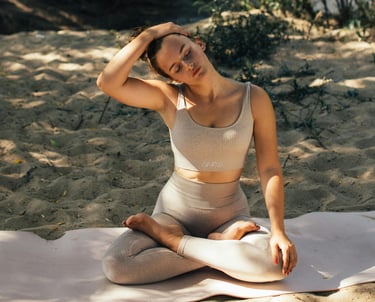

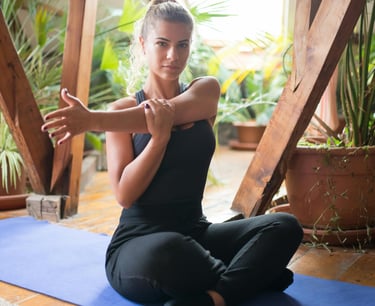





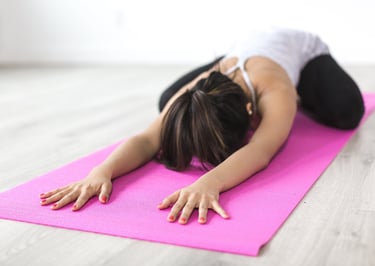

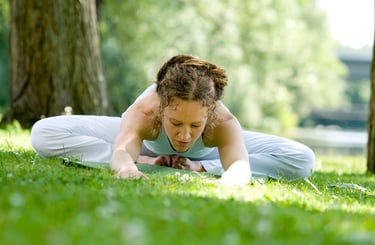

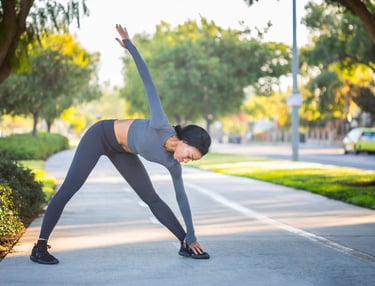



2. Child's Pose
1. Neck
3. Shoulder
7. Revolving Lunge
5. Hip Adductor
6. Triangle / Hamstrings
4. Upward Dog
8. Bridge, don't arch back
9. Hip Flexor
10. Pigeon / Glutes

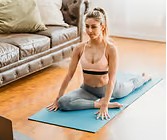
11. Cat-Cow
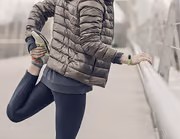

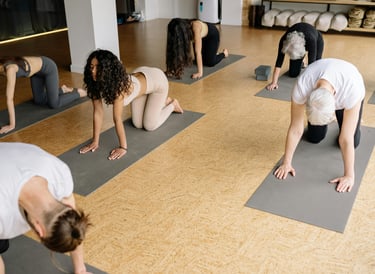

12. Quads
More Mobility and No Pain


Knees to Chest - Lie on your back, legs straight, pull right knee to chest, hold. Repeat with the left knee. Next, pull both knees into the chest, hold. Helps lower back, hips, thighs.
Figure 4 Glute - Sit in a chair with back straight. Cross the right leg over the left, foot flexed into an "L" shape. If the crossed leg isn't parallel with the floor, gently press the knee down. Hold for 30 seconds. Straighten the leg that's on the floor to see the figure "4". Repeat and cross the left leg over the right. Helps glutes, adductors, range of motion in hips, decreases hip & back pain.
Side Stretch - Stand with legs about hip distance apart, stretch both arms up high, bending to your right, hold. Repeat bending left, hold. Helps balance, core, side of body, range of motion in upper body & spine, tension relief in shoulders & neck, possible lower back pain relief.
Spinal Twist - Lie on your back with legs straight, guide right knee/leg over to the left, gently press with left hand so knee touches the floor. Keep both shoulders on the ground. Hold. Repeat guiding the left knee/leg over to the right. Helps glutes, hips, back, range of motion in spine, relieves tension in lower back & hips.
#6 Triangle - To see #6 photo. Stand with legs wider than shoulder width apart. Hold your arms out to the sides. Bend at the hips, right hand grabs right foot, left hand reaches to the ceiling. Hold. Repeat on the left. Helps shoulders, chest, hamstrings, hips, glutes, ankles.
#12 Quads - To see #12 photo. Stand, or lie down on your side. Bend the right knee and gently pull your heal to your butt. Hold for 30 seconds. Repeat with the left side. Helps quads, hip flexors, range of motion in hips & knees.
#7 Revolving Lunge - To see #7 photo. Lunge forward with right leg, left knee can be on the ground or leg straight back. Left palm on floor, right hand reaches to ceiling. Hold. Repeat with left leg lunging forward. Helps quads, glutes, hamstrings, spine, shoulder, chest, stomach, enhances endurance & balance.
#1 Neck - Click to see #1 photo. Tilt your head to the right, apply gentle pressure down with your right hand, hold. Repeat on the left. Next, turn your head and look over the right shoulder, hold. Repeat on the left.
#11 Cat Cow - To see #11 photo. Cat: arch head/neck up, mid/low back arches down, breathe in slowly. Cow: lower head/neck down, push with your palms and arch mid/upper back up, belly sucked in, breath out slowly. Repeat several times. Helps spinal mobility, neck, shoulders, decreases back pain, relaxing.
#2 Child's Pose - To see #2 photo. Knees apart, toes touching, bend from the hips and stretch forward. Keep the butt back & down towards your heels and your back flat. Hold. Helps open the hips & ankles, stimulates digestion, lengthens & relaxes the back, helps blood flow to the head/neck.
Shoulder Rolls - Roll both shoulders forward, up, and back several times, Then reverse: rolling back, up, and forward. Repeat the forward/backward circles except lift your shoulder & arms, elbows bent. Helps shoulder mobility.
Standing Lift & Forward Fold - Stand and clasp hands together. Lift your arms/shoulders as high as you can above your head, palms facing up, head up. Hold. Unclasp your hands, bend from the hips not the waist, touch the floor. Hold. Inhale. Exhale as you stretch further, with knees slightly bent if needed. With more flexibility, you can palm the floor. Repeat several times. Helps upper body, spine, glutes, hamstrings, hip flexors, calves, and digestive system.
Morning Stretch for Mobility


Whether you're typically inactive, sit for hours at a desk, or you just woke up from a nights sleep - you need a good stretch for 5 - 20 minutes. First, it's critical to get your circulation (blood flow) moving - which will magically awaken your body. You'll feel invigorated as your muscles lengthen & your whole body comes alive.
After sitting a couple hours: warm up for 1 minute, stretch 5 minutes.
After sleeping: warm up for 2 minutes, stretch 15-20 minutes.
For a quick review: Caution: Proper Stretching Methods.
Spend most of your time focusing on the neck, back, hip flexors, hips, quads, hamstrings, and glutes since those are often the most stiff and they're the most used for correct posture and mobility.
Stretch gently and don't force it. Include full range of motion mobility movement, and twisting & bending movements.
Choose some of the basic stretches in the photo's above or the ones listed below.
Stretching Poses Explained
Static Stretch Routine: 10-20 mins
Give more attention to stretching the large muscle groups you just used - always including some back and leg stretches since these are used for almost everything. Also, stretch both sides of your body equally to remain properly aligned. If one side is not as flexible as the other, spend extra time on it to help correct imbalances on the left or right side. For intense workouts - stretch 20 minutes or more.
Include forward bends & back-bending stretches, as well as spinal twists to keep your back healthy, flexible, and mobile. It's also important to relax your body and breathe deeply & slowly as you stretch. Don't stretch any further once it get's a little uncomfortable - you'll get more flexible with time. Review the: "Caution: Proper Stretching Methods".
After Workout = Static Stretch
Dynamic means constantly changing. Therefore, a dynamic stretch is NOT a stretch that you hold - it's a type of stretch using mobility movements before you exercise to warm up your muscles, get your blood pumping, and oxygen flowing. If you workout with cold muscles - they'll easily get pulled/strained, and the tendons & connective tissues will easily tear.
Focus on dynamic movements for the muscles you'll be using. For example: for leg day, focus more on moving the lower body. Always give some attention to the back & legs, since they're always used. For more intense exercise - increase the dynamic mobility movement warm-up to 5 to 10 minutes.
Before Workout = Dynamic Stretch




Static stretch: after your workout.
Stretch, breathe, relax, and focus more on the muscles that were used during the workout or activity.
Still stretching: age 35 vs. 75.
Get your stretch on Grandpa!


Dynamic Mobility Routine: 3-5 mins
For 1 minute - jog in place, do jumping jacks, or other mobility moves to get the blood flowing & core temperature up.
Stand with legs hip distance apart, keep the legs/hips pointed forward, lift arms straight out from the shoulders. Twist the upper body to the right, then left as far as you can. Repeat 15 seconds to warm up the back.
For lower body day: start with #1-2 above to warm up the muscles & back.
Stand with the right leg slightly behind you, then kick it forward up to waist level. At the same time, touch your toe with your left hand 8 times. Repeat with the left leg.
Hip circles = stand on the left leg, lift the right leg up with bent knee and around to the right and back down. Stand on the right leg, lift the left leg up with bent knee and around to the left and back down. Repeat 5-6 times each leg.
Do 8-10 repetitions each with light weights: squats, deadlifts, and side lunges (each leg). Girls: 10 pounds max. Guys: 15 pounds max.
For upper body day: start with #1-2 above to warm up the muscles & back.
Stand with legs hip distance apart, hold arms straight out on both sides. Swing your arms and give yourself a quick hug with the right arm on top. Then swing with the left arm on top. Repeat for 15 seconds.
Circle the arms in front of you up to your head and down behind you, then switch and circle your arms up from behind to your head and down the front to your sides. Repeat for 15 seconds.
Do 8-10 repetitions each with light weights: overhead press, bicep curls, triceps extensions. Girls: 8 pound max. Guys: 12 pound max.
If you are relatively inactive and/or don't have an upright and properly aligned posture - it's likely you have inflammation and pain in your body. Stretching can release the Endorphin hormone which is a natural pain killer. Stretching in general is also an excellent way to decrease inflammation and pain. Depending on the cause, you may get immediate pain relief or it may take 1-3 weeks of consistent stretching where you gradually go from a little stretch to a deeper stretch.
If you start exercising or suddenly spring into action and your muscles have not been warmed up - you're likely to pull a muscle or tear a tissue, followed by pain & inflammation. Consult with a medical professional before beginning a new stretching routine to make sure nothing was torn or sprained.
One of the most common areas of pain is in the lower back and yoga stretches are excellent when it comes to spinal health & mobility. Did you know back pain is more common as we age, beginning around age 30-40? Pain is also more common for those carrying extra weight and, those who are inactive. Specific Yoga stretches have had great success in alleviating pain due to spinal injuries, arthritis, and other ailments.


Stretch for No More Pain


Lower Back Pain
Common causes of pain: inactivity or lack of proper stretching after workouts in the butt and hip area. Pain can also arise if you're putting more pressure on one side of your body to compensate for a tight muscle/tissue or a strained muscle/tissue on the opposite side of your body. If you have an injury - see below.
Imbalances will cause other issues if you don't remedy the situation by stretching. If one side feels tighter and not as flexible - give it more time to correct the imbalance.
See: Stretching Poses and refer to #2 Child's post, #4 Upward dog, #6 Triangle/Hamstring, #7 Twisting lunge, #10 Pigeon/Glutes, #11 Cat-Cow.
Also see: Morning Stretch for Mobility in the bottom 1/2 of that section - "Knees to Chest", and "Figure 4 Glutes". Depending on where the pain is and what caused it - certain stretches are more beneficial.
You could also try a foam roller on your lower back as I've heard a few people say it helps.
Consult a Physical Therapist for Pain Management
Consult with a physical therapist or other professional about natural methods like stretching you could do to decrease the pain you're experiencing. Stretching is preferred over medication, because a pill will only mask the pain without fixing the root cause.
If you have an injury - a physical therapist can advise you on specific gentle stretches to help the injury heal.
Live your life with very little or no pain, with strength and mobility....
and keep having FUN beyond age 60 and 70.
